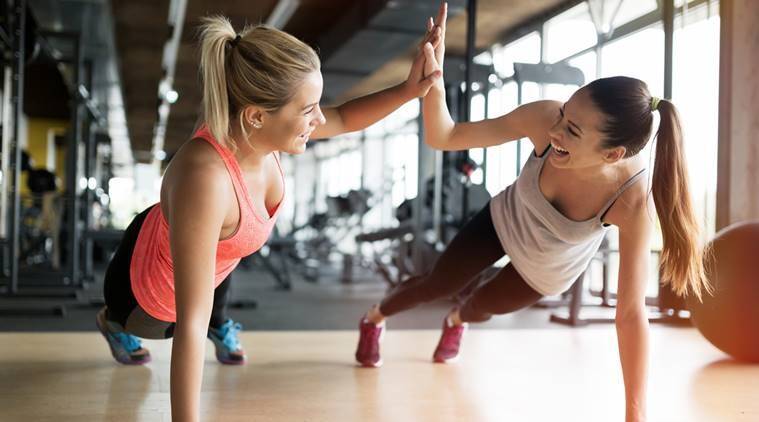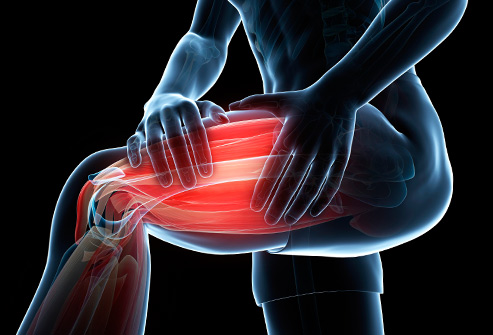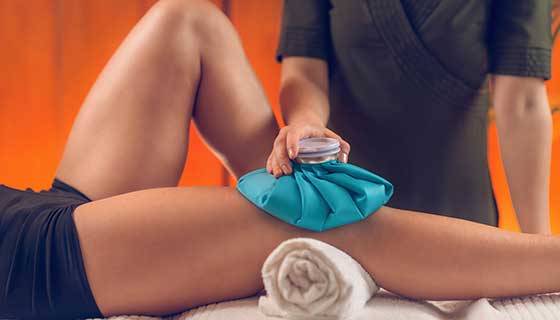Muscle twitching is the involuntary contraction of a muscle that causes it to twitch or contract. It may feel like a muscle spasm and usually ends with the muscle relaxing. Muscle twitching after a workout occurs when muscles are fatigued, overheated, or injured.
It is common for people who work out regularly to experience muscle twitching after a workout. But in some cases, muscle twitching after a workout can be an early sign of neurological disorders such as amyotrophic lateral sclerosis (ALS) or neuropathy. This blog will discuss the symptoms of muscle twitching after a workout and how to treat it. It will also cover risk factors and prevention methods so that you can continue to work out without worrying about muscle twitching after workouts.
What is Muscle Twitching After Workout?
Muscle twitching after exercise is a normal occurrence. – It is a reflex action caused by contraction of muscles spasm and release of neurotransmitters. It occurs due to fatigue, electrolyte imbalance, or muscle damage.
What is Muscle Twitching and is it normal after workout? Check it out!!!
Symptoms of Muscle Twitching After Workout
Symptoms of muscle twitching after workout include uncontrollable shaking or twitching in the affected muscle group. The individual may also experience pain or soreness in the affected area, stiffness and difficulty moving the affected muscles, weakness and fatigue in the affected area after exercise. In most cases, muscle twitches are a harmless response to a nerve stimulus, but can be disconcerting for individuals who experience them. As with any medical condition, it is vital to consult a medical professional if any of the aforementioned symptoms persist or worsen.
Risk Factors for Muscle Twitching After Workout
- Muscle twitching after exercise is usually caused by dehydration, electrolyte imbalance, or overtraining.
- Common causes of muscle twitching after exercise include dehydration, electrolyte imbalance, and overtraining.
- If you are experiencing muscle twitching after a workout, try taking in more water to stay hydrated, perform a proper warm-up and stretching before any physical activity, and limit the amount of strenuous activity you do.
- Moreover, if you experience muscle twitching after a workout, consult with your doctor to rule out any underlying medical condition.
Treatment Options for Muscle Twitching After Workout
If muscle twitching occurs after a workout, it’s important to treat the condition as soon as possible. Here are some steps you can take to improve muscle health and reduce the risk of muscle twitching after exercise:
Over-the-Counter Medications
Over-the-counter (OTC) medications such as ibuprofen and acetaminophen can help reduce muscle twitching after a workout. These medications are safe to use in limited doses and should only be taken for short periods of time to avoid overdose.
Other treatments include stretching exercises, massage therapy, heat packs, and cold packs that can provide temporary relief. It is important to rest and recover between workouts to allow the muscles time to mend.
Additionally, it is essential to stay hydrated and consume an adequate amount of electrolytes to aid in recovery. It is best to get adequate rest between workouts to allow the body time to repair and recover from exercise.
Physical Therapy
Muscle twitching after a workout is common and can be caused by various factors, such as physical exertion, dehydration, muscle fatigue, and muscle inflammation. Physical therapy can help to alleviate muscle twitching by helping to reduce inflammation and improve range of motion. It can also help to strengthen the muscles, which can reduce the frequency of muscle twitching.
To prevent muscle twitching after a workout, stretching is an effective way to increase circulation and reduce tension in the muscles. Ice or heat therapy can also be used to treat muscle twitching after a workout to help relieve pain and increase recovery. Heat therapy helps to increase circulation and relax while cold therapy can reduce inflammation and pain.
Heat/Cold Application
Heat or cold therapy can help reduce the symptoms of muscle twitching. Applying heat to the affected area helps to relax tight muscles and increase circulation. Cold therapy helps to reduce inflammation, which can reduce pain and discomfort. Other treatments, such as massage, stretching, and rest, can also help reduce muscle twitching after a workout.
In most cases, muscle twitching after a workout will disappear on its own with time. However, if the muscle twitching persists or becomes severe, be sure to seek medical attention. Your healthcare provider may recommend other treatment options such as anti-inflammatory medications or muscle relaxants.
It is important to follow any treatment recommendations you receive from your healthcare provider carefully to ensure your recovery is successful and symptom-free.

Massage
Massage is a great way to relax the muscles and relieve tension after a workout. Massage can help reduce muscle twitching and improve circulation, which can help with muscle recovery. Stretching is also beneficial for relieving muscle tightness and soreness.
To prevent muscle twitching, it is important to hydrate and eat a well-balanced diet. Nutrition and rest are essential for helping muscles recover after exercise. It is vital to allow your body time to heal and repair itself. A good workout routine, nutrition plan, and good sleep schedule can help you reach your goals faster and more effectively.
If you are experiencing muscle twitching after a workout, consider some of the treatment options listed above to help reduce muscle spasms and speed recovery.
How to Prevent Muscle Twitching After Workout?
After a hard workout, muscle twitching is common. This is caused by muscle spasms after exercise and can be annoying but it doesn’t usually cause any serious harm. It’s important to prevent this condition by following some simple guidelines.
Balance Diet is A Key
• To ensure that your muscles stay healthy and strong, it’s important to eat a balanced diet that includes enough protein and carbohydrates.
• In addition to consuming enough protein and carbohydrates, it is also essential to consume enough healthy fat, fruits, and vegetables to provide the body with all of the vitamins and minerals it needs to function properly.
• Additionally, staying hydrated with water or sports drinks can help support muscle health. Another way to prevent muscle twitching after a workout is by engaging in regular stretching before and after workouts.
• By stretching your muscles, you can help prevent post-workout muscle twitching. Additionally, staying active throughout the day can help keep your muscles strong and healthy.

Warm Up and Cool Down
To prevent muscle twitching after workout, it’s important to engage in proper warm-up and cool down exercises before and after your workout. These steps prepare your muscles for activity and reduce the risk of injury. Also, stretching after your workout helps relax the muscles, reduce soreness, and prevent muscle twitching.
Preventing muscle twitching after workout requires hydration and rest between workouts. By taking care of these factors, you can help avoid muscle twitching and keep your body strong and healthy.
Stay Hydrated
Due to muscle twitching after a workout, muscles may appear weak and fatigued. Muscle twitching can be caused by dehydration and electrolyte imbalances. To prevent muscle twitching after exercise, it is important to stay hydrated before, during, and after exercise.
By staying hydrated, you help to replace lost electrolytes and maintain the health of your muscles. Additionally, electrolyte imbalance can lead to muscle twitching, so it’s vital to replenish lost electrolytes with sports drinks or other electrolyte-rich foods.
For a quick fix for muscle twitching after exercise, stretching before and after a workout can help reduce muscle tightness that can lead to cramping and twitching.
Eat Right for Recovery
Eating the right foods is important for recovery after a workout. Besides providing your body with nutrients to help recover from the workout, eating the right foods can also reduce the risk of muscle twitching. To promote muscle recovery, choose nutrient-dense, high-quality proteins and complex carbohydrates.
These foods will help provide your body with the building blocks to repair and grow from workout to workout. In addition to protein and carbs, include low-fat dairy in your diet for added sources of calcium and vitamin D. Additionally, make sure to get enough fluids throughout the day to stay hydrated and prevent cramping. Make sure to get adequate rest in between workouts to allow your muscles time to recover and avoid muscle twitching.
Get Enough Sleep
Muscle twitching after a workout is common and can occur as a result of overuse or fatigue. However, muscle twitching can also be a sign of an underlying medical condition. Getting enough sleep is essential for muscle recovery after a workout, so aim for at least 7-8 hours of quality sleep per night to ensure your body has time to rest and repair itself.
Moreover, staying hydrated can help reduce muscle twitching, so make sure to drink plenty of water throughout the day. It is also vital to warm up and cool down properly before and after a workout to help avoid muscle twitching. Additionally, stretching regularly can help improve flexibility and reduce muscle twitching. Finally, listen to your body and avoid overworking your muscles if you experience muscle twitching.

Take Regular Breaks During Workouts
Regular breaks during workouts are essential for allowing muscles to recover and reduce the risk of muscle twitching. It’s important to give yourself enough rest between sets, taking at least one full day off from working out each week. Besides, make sure you stay hydrated and fuel your body with the proper nutrients by eating a balanced diet. Finally, massage therapy or foam rolling into your routine to promote healthy circulation in your muscles can help reduce the risk of muscle twitching.
Answers You Want To Know
1. When should I worry about muscle twitching?
- If you find yourself with muscle twitching after exercise, it is usually nothing to worry about. However, if the twitching persists or causes pain, then it could be a sign of a more serious underlying issue, such as a pinched nerve or muscle strain. In these cases, it is best to consult a medical professional to get an accurate diagnosis and treatment plan.
- In addition, if the muscle twitching is accompanied with other symptoms like numbness, weakness or loss of coordination, then it is also a good idea to see your doctor.
- Finally, there are several steps that can help you reduce the risk of muscle twitching in the future. This includes warming up before any physical activity, stretching regularly and keeping hydrated during workouts. These simple steps can help prevent muscle twitching and reduce the risk of further injury.
2. What deficiency causes twitching muscles?
Twitching muscles can be the result of nutrient deficiencies in your diet. Here are some of the most common deficiencies that can cause twitching muscles:
- Vitamin B12 deficiency: B12 is an essential vitamin for muscle contraction and nerve health. Without enough of this vitamin, you may experience muscle twitching or cramping.
- Magnesium deficiency: Magnesium is important for muscle relaxation and contractions. If you’re lacking magnesium, it can lead to muscle twitching or cramps.
- Potassium deficiency: Potassium is important for muscle contractions and nerve function. If you have too little potassium in your body, it can cause involuntary muscle spasms or contractions.
- Calcium deficiency: Calcium is essential for muscle contraction and nerve transmission. Low calcium levels can lead to involuntary contractions in the muscles, as well as tremors.
3. What is the most common cause of muscle twitching?
Muscle twitching is a common symptom of muscle fatigue or dehydration. When your muscles are overly tired, they can spasm and twitch in response to the fatigue, leading to an uncomfortable twitching sensation. Dehydration can also cause muscle twitching as electrolytes become imbalanced and there is an imbalance of electrolytes like potassium, sodium, calcium, and magnesium.
In some cases, muscle twitching may be a sign of nerve damage or vitamin deficiencies such as Vitamin B12, calcium, or magnesium.
If you experience muscle twitching after exercising, it’s important to rest and rehydrate. Taking an electrolyte supplement may help reduce muscle twitching, as well as eating potassium-rich foods to replenish electrolyte levels. You should also avoid caffeine and alcohol while experiencing muscle twitching as they can worsen dehydration.
4. What does twitching muscles indicate?
Muscle twitching can indicate a variety of conditions, some of which are harmless and some of which may need medical attention. Twitching is usually caused by fatigue, dehydration, or electrolyte imbalance; drinking water and getting enough rest can help alleviate this type of muscle twitching.
However, if the muscle twitching persists after taking those steps, it could be indicative of an underlying medical condition like multiple sclerosis or myasthenia gravis. In such cases, it is best to consult with a doctor for further diagnosis and treatment.
Overall, muscle twitching is usually not harmful but should still not be ignored if it persists or is accompanied by other symptoms. If you experience muscle twitching that is worrisome, consulting with a doctor is the best option to determine the underlying cause and potential solutions.
Words From Sheru Classic
Muscle twitching after exercise, or muscle cramping, is not uncommon. While it may be uncomfortable and worrisome, muscle twitching generally isn’t a cause for alarm. Depending on the severity of the muscle cramp and how long you’ve been experiencing the symptoms, there are several self-care options to try at home. If muscle twitching persists or causes severe pain or discomfort, it is best to consult your doctor.




